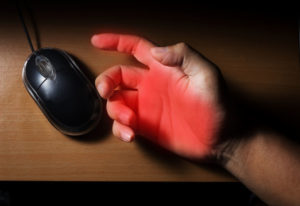 Trigger finger sounds like a tool in a video game, but it’s actually a serious orthopedic condition that occurs when a finger gets stuck in a bent position. This painful issue leads the finger to bend or straighten with a snap, just like a trigger being pulled and released. Trigger finger is also known as stenosing tenosynovitis, and it occurs when inflammation reduces the space within the sheath surrounding the tendon in the affected finger.
Trigger finger sounds like a tool in a video game, but it’s actually a serious orthopedic condition that occurs when a finger gets stuck in a bent position. This painful issue leads the finger to bend or straighten with a snap, just like a trigger being pulled and released. Trigger finger is also known as stenosing tenosynovitis, and it occurs when inflammation reduces the space within the sheath surrounding the tendon in the affected finger.
If you have a job or hobby that requires repetitive gripping actions, you are automatically at a higher risk of developing trigger finger. Fortunately, treatment is easy to obtain from an orthopedic doctor. Here is everything you should know about treatment!
Signs You May Have Trigger Finger
In order to pursue treatment for trigger finger, you first need to identify the problem. Symptoms of trigger finger can range from mild to severe, including finger stiffness, a popping or clicking sensation when you move your finger, difficulty straightening your finger at all, and tenderness at the base of the finger. These symptoms might affect one or more fingers, including the thumb.
Noninvasive Therapy Treatments
It is possible to minimize your trigger finger symptoms with noninvasive treatments like resting your fingers, wearing a splint at night, and completing certain stretching exercises. If these methods can help to minimize inflammation in your tendon, then your finger pain and stiffness may subside.
Medical Treatments
If noninvasive therapy fails, there are a few other options to explore. The first is a steroid injection near or into the tendon sheath. This could reduce inflammation and allow the tendon freedom to glide as you bend your fingers. Most people treated with steroid injection are able to enjoy results for about a year before another injection is needed.
A percutaneous release is another option for trigger finger. This is a more invasive treatment than steroid injections, but it also has the potential deliver permanent results. During a percutaneous release, your palm will be numbed so that your doctor can insert a sturdy needle into the tissue around your affected tendon. My moving the needle and your fingers in a certain manner, your doctor can break apart the blockage that is preventing smooth motion of the finger tendon. Surgery to cut open the constricted section of tendon sheath is also an option.
If you’re ready to escape the pain of your own trigger finger condition, just call (941) 485- 1505 to make an appointment at one the many locations of Suncoast Orthopaedic Surgery & Sports Medicine throughout Sarasota County. Suncoast Orthopaedic Surgery specializes in the diagnosis and treatment of athletic and degenerative conditions of the musculoskeletal system, so you will get the expert help you need.
